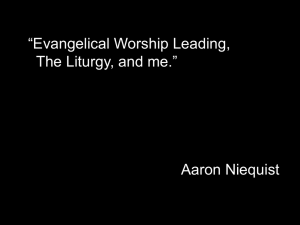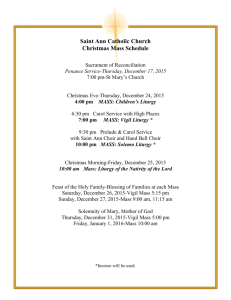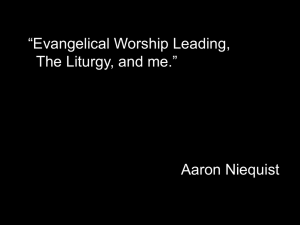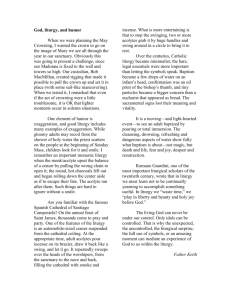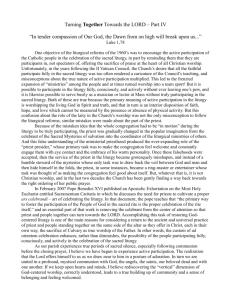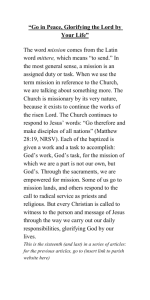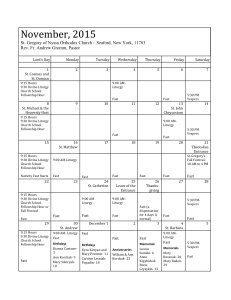downloaded - Midwest Theological Forum
advertisement
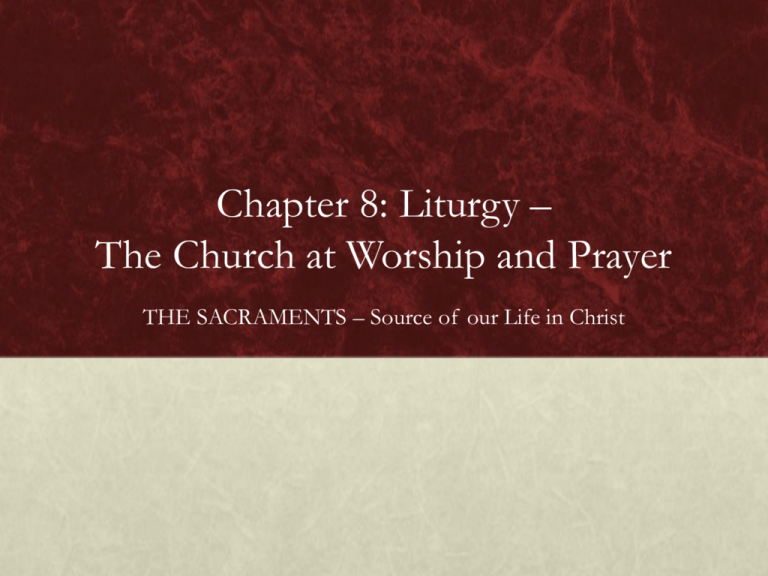
Chapter 8: Liturgy – The Church at Worship and Prayer THE SACRAMENTS – Source of our Life in Christ 1. What is the Liturgy? (pp. 208-213) Anticipatory Set Opening Prayer on Revelation 5:8-12, a vision of the heavenly liturgy. 1. What is the Liturgy? (pp. 208-213) BASIC QUESTIONS What is the relationship between the earthly and heavenly liturgy? Where did the Christian liturgy come from? Who do we encounter in the liturgy? KEY IDEAS The Christian earthly liturgy, or public worship of God, is a real participation in the eternal heavenly liturgy. The Christian liturgy developed from the worship of the Jerusalem Christian community that spread throughout the Roman world, especially in Antioch, Alexandria, and Rome. We really encounter Jesus Christ in the liturgy, a meeting for which we should prepare ourselves. 1. What is the Liturgy? (pp. 208-213) Focus Questions What does Revelation 5:8-12 picture in symbolic language? The heavenly liturgy. What is the heavenly liturgy? It is the continual worship of God that the angels and saints offer in Heaven. To whom is worship offered in Heaven, according to Revelation? God and the Lamb, Jesus Christ. Why did Christ institute the Sacraments? Christ instituted the Sacraments to continue his saving ministry on earth. Christ is present in every Sacrament, giving us God’s grace. Where is the mystery of Christ’s salvation most effectively encountered on earth? In the liturgy of the Church, especially in the Eucharistic liturgy of the Mass. 1. What is the Liturgy? (pp. 208-213) Guided Exercise Perform a paragraph shrink on the paragraph beginning, “In the liturgy of the Mass” (p. 208) to understand the relationship between our current worship, the sacrifice of Christ on earth, and the worship in the heavenly liturgy. (N.B. This is a very complex concept that can be formulated in a number of ways.) 1. What is the Liturgy? (pp. 208-213) Focus Questions What does the word “liturgy” refer to in this text? All the rituals and ceremonies celebrated in the Church, especially the Mass. In what sense are Catholic liturgical rites “set” or not impromptu? The Sacraments and other rites are to be celebrated in the prescribed and approved manner that the Church determines. With what rite are most of us most familiar? The Latin or Roman Rite. What are some other liturgical rites in the Catholic Church? The Antiochen, Alexandrian, Milanese, Gallican, Maronite, and Mozarabic Rites. What do all these rites have in common? They all contain the same essential elements of worship that have a common origin in Jesus Christ and in the practices of the apostolic Church in Jerusalem. 1. What is the Liturgy? (pp. 208-213) What is the etymology of the word liturgy? It comes from two Greek words: leiton (of the people) and ergos (work). What did liturgy originally mean? For the pagan Greeks, it meant public service performed by Greek citizens for the good of the state. How was the word liturgy used in the Septuagint? It was used to describe the public worship in the Jewish Temple in Jerusalem, which was performed according to the Law of Moses. How did the first Christians use the word liturgy? They used it to describe their common worship in Jerusalem. 1. What is the Liturgy? (pp. 208-213) Guided Exercise Do a focused reading of the final three paragraphs on page 210 (beginning with “Following the instructions”) using the following question: How did the Church develop different liturgical rites? 1. What is the Liturgy? (pp. 208-213) Focus Questions What is an iconostasis? It is the screen of icons, used in Eastern churches, which separates the nave from the sanctuary and altar. What are the two parts of an Eastern church? The nave, where the people assemble, and the sanctuary, where the Eucharist is celebrated on the altar. What does the iconostasis represent? The division and meeting place between Heaven and earth. Where are Heaven and earth united? In the Eucharistic liturgy. The iconostasis becomes, as it were, the door to Heaven. 1. What is the Liturgy? (pp. 208-213) Focus Questions How is the liturgy both public and interior? It is public because it is celebrated by the Church and Christ. It is interior because it calls for us to turn our hearts and minds to God and not just thoughtlessly perform actions. What are the interior dispositions the grace of the Holy Spirit gives us to prepare us for the liturgy, according to CCC 1098? The grace of the Holy Spirit seeks to awaken our faith, convert our hearts, and help us adhere to God’s will. What is active participation in the liturgy? Understanding it, following it, and meditating on it, along with participating in prayer and song. 1. What is the Liturgy? (pp. 208-213) Focus Questions What gives the liturgy its effectiveness? God gives the liturgy its meaning and effectiveness. What are the various ways in which Christ is present in the liturgy? In the Sacraments, because they are the continuation of Christ’s saving actions in our lives. In the proclamation of the Word, because Jesus is literally the Word of God. In the prayer of the Church, because two or three are gathered. And in acts of charity, because what we do for one in need we do for Christ. 1. What is the Liturgy? (pp. 208-213) Closure Write a paragraph defining liturgy and summarizing the relationship between the heavenly and earthly liturgies. 1. What is the Liturgy? (pp. 208-213) Homework Assignment Reading: Pp. 213-218 Questions: Questions: 1-7. Workbook: 1-9. Practical Exercise 1. 1. What is the Liturgy? (pp. 208-213) Alternative Assessment Work with a partner to formulate a question about something that was difficult to understand in this lesson, and then try to come up with an answer. Briefly share questions and responses. 2. The Church’s Visible Worship (pp. 213-218) Anticipatory Set Scan the list and description of physical objects found in a typical parish church (p. 215). Identify and learn about one object you weren’t familiar with before. Briefly share responses. 2. The Church’s Visible Worship (pp. 213-218) BASIC QUESTIONS Why do Christians worship God on Sunday? What is the significance of the Church building? Why do we use physical objects and human gestures in our worship of God? KEY IDEAS The early Church combined the Saturday Sabbath synagogue worship with the Sunday “Breaking of Bread” liturgy to form the Mass, which was celebrated on Sunday, the first day of the week and the day of the Resurrection. Churches are physical signs of the Church and of Christ, where he is worshiped and reserved in the Eucharist. Because we are physical/spiritual beings, we pray using material substances and human actions to signify invisible spiritual realities. 2. The Church’s Visible Worship (pp. 213-218) Focus Questions On what days did the first Christians worship God? They worshipped God in the synagogue or the Temple on the Sabbath (Saturday) and celebrated the Eucharist on the Lord’s Day (Sunday). How did Christians go from two to one day of worship? In time, the early Christians combined these two liturgies, the Liturgy of the Word, which came from synagogue worship, and the Liturgy of the Eucharist, into one act of worship on Sunday, the Lord’s Day, or the day of the Resurrection. What is important about the eighth day? On this day, God recreated humanity as children of God in the order of grace through the Resurrection of Christ. Why are Catholics required to attend Mass and refrain from servile work on Sunday? In obedience to the First and Third Commandments. 2. The Church’s Visible Worship (pp. 213-218) Focus Questions What are Holy Days of Obligation? They are days that commemorate important saints, events in salvation history, and mysteries of the Faith. Why does the Church want and require us to attend the liturgy of the Mass on Sundays and Holy Days? So we can center our minds and hearts on the mysteries of Christ’s redemption, make him the focal point of our lives, and receive grace. 2. The Church’s Visible Worship (pp. 213-218) WHERE WE WORSHIP Focus Questions Where was God to be worshipped in the Old Testament? In the Temple in Jerusalem. Where can we worship God in the New Covenant? Anywhere, because all the earth is holy and has been entrusted to man. What makes any place where Christians gather a spiritual edifice? The faithful are themselves “living stones” that “build a spiritual house” (1 Pt 2:4-5). 2. The Church’s Visible Worship (pp. 213-218) Guided Exercise Conduct a Think/Pair/Share on the following question: How is a church a sign of God and Heaven? Guided Exercise Explore an internet site on the history of stained glass windows with many examples of windows that light, beatify, and teach about the Faith. 2. The Church’s Visible Worship (pp. 213-218) Focus Questions Why does our worship include physical signs and gestures? Because we are a unity of body and soul and the physical is necessary to us. What are some examples of the use of natural substances and human actions in liturgy? We use the natural substances of light, water, fire, oil, colors, and sounds, as well as the human actions of washing, anointing, breaking bread, kneeling, bowing, reading, and listening in our liturgy. How does the physical and spiritual work together in the Sacrament of Baptism? Physical words and the pouring of water remove sin from the soul of the baptized person and give grace. 2. The Church’s Visible Worship (pp. 213-218) Guided Exercise: mini-lesson on the words spiritual and soul. What do you think the two terms mean? When the Church speaks of the “soul” of a human being, it means the life-giving principle the person possesses which is immortal and contains the faculties of reason and free will. Christian philosophy traditionally defines the human person as a unity of body and soul: man is an ensouled body or embodied soul. “Spiritual” is an imprecise term used in many ways. In Christian philosophy, spiritual can mean having to do with the faculties of the soul: reason and the exercise of free will. In this sense, reading is a “spiritual” activity: it is done by the intellect. An act of love or even of hate is spiritual because it springs from a free act of the will. Spiritual can mean having to do with God and grace as in “spiritual life”. For human beings, we cannot just be spiritual and leave the bodily. On the most elementary level, if we don’t eat our body will die, separating the soul from it. On a more advanced level, everything in our intellects gets there through the five senses. Because we are a unity of body and soul, our religious activities must include both. What we see and hear and smell and the actions we perform with our bodies all contribute to or take away from our prayer and worship. 2. The Church’s Visible Worship (pp. 213-218) Guided Exercise After reading THE SIGN OF THE CROSS, practice the following: The Latin Sign of the Cross. The Eastern Sign of the Cross. The blessing hand gesture. The five wounds of Christ hand posture. The Easter Trinity and Two Natures of Christ hand posture. 2. The Church’s Visible Worship (pp. 213-218) Guided Exercise Complete the following graphic to identify what the various gestures in the liturgy mean and when they are employed. Gesture Sign of the Cross Striking Breast Anointing Ashes Laying on of Hands Joining hands at the chest Standing Kneeling Sitting Bowing the Head Bowing the Body Procession Gestures in the Liturgy Meaning Example of When Used 2. The Church’s Visible Worship (pp. 213-218) Gesture Sign of the Cross Striking Breast Anointing Ashes Laying on of Hands Joining hands at the chest Standing Kneeling Sitting Gestures in the Liturgy Meaning The Cross and the Trinity. Contrition and humility. The Holy Spirit, special election, healing. Humility, repentance and resurrection. Consecration and supernatural action. Prayer, humility and submission. Joy and adoration of God. The Resurrection. Repentance and adoration. Bowing the Head A disciple listening to a teacher. Reverence. Bowing the Body Reverence. Procession The pilgrim Church. Example of When Used When entering a church. During the Confiteor. In Confirmation. Ash Wednesday. Holy Orders. When praying. During the reading of the Gospel at Mass. During the Consecration at Mass. During the homily. When the name of Jesus is said. During the Profession of Faith when we recall the Incarnation. At the beginning of Mass when the priest goes up to the altar. 2. The Church’s Visible Worship (pp. 213-218) Closure Write a paragraph explaining why Catholics attend Mass on Sunday, taking into account both the particular day and the nature of the obligation. 2. The Church’s Visible Worship (pp. 213-218) Homework Assignment Reading: Pp. 219-221. Questions: Questions: 8-10; 12 & 14. Workbook: 10-22. Practical Exercise 2. 2. The Church’s Visible Worship (pp. 213-218) Alternative Assessment Free write on what you consider the most interesting or meaningful physical substance or human gesture the Church uses in the liturgy. 3. The Liturgy of the Hours, Liturgical Objects Anticipatory Set Pray one of the offices of the Liturgy of the Hours. The night prayer, for example, can be downloaded from the following site. http://www.ebreviary.com/ 3. The Liturgy of the Hours, Liturgical Objects BASIC QUESTIONS What is the Liturgy of the Hours? What are the various liturgical vestments, vessels, seasons, and colors? KEY IDEAS The Liturgy of the Hours, or Divine Office, consists of psalms and readings by which the Church obeys Christ’s command to pray always. The Church uses specific liturgical vestments and vessels and has specific liturgical seasons with different colors to reflect liturgical themes. 3. The Liturgy of the Hours, Liturgical Objects Focus Questions What command of Christ does the Church fulfill through the Divine Office, or Liturgy of the Hours? Jesus’ command to pray constantly. How many times a day is the Liturgy of the Hours prayed? Seven. Who is obliged to pray the Liturgy of the Hours? All clergy and members of religious orders. Who is urged to pray the Liturgy of the Hours, or, at least, part of it? Everyone. 3. The Liturgy of the Hours, Liturgical Objects Guided Exercise Work with a partner to summarize how the Liturgy of the Hours developed. Guided Exercise “Field trip” to the school chapel. 3. The Liturgy of the Hours, Liturgical Objects Guided Exercise Create your own graphic organizer to organize the knowledge presented on liturgical seasons and vestments. 3. The Liturgy of the Hours, Liturgical Objects Closure Write a paragraph summarizing the content of this lesson. 3. The Liturgy of the Hours, Liturgical Objects Homework Assignment Reading: Pp. 222-227 (through “STATIONS OF THE CROSS”). Questions: Questions: 11, 13, 15-16. Workbook: 23-31. 3. The Liturgy of the Hours, Liturgical Objects Alternative Assessment Look up one of the offices of the Liturgy of the Hours (for example Morning Prayer for a specific day) and then make a list of the various sources for the prayer contained therein. How “Biblical” do you find it in its sources? 4. Sacramentals of the Church (pp. 222-227) Anticipatory Set Over the course of a week incorporate all fourteen (or fifteen) stations of the Cross in the class’s opening prayer, using an image of each station, a short meditation, the traditional prayers, and the proper postures. One example can be found on-line at the following address: http://www.catholic.org/clife/prayers/station.php. 4. Sacramentals of the Church (pp. 222-227) BASIC QUESTIONS What are sacramentals? What is Holy Water? Why do Christians venerate statues, icons, and other images? What is the Rosary? What are the Stations of the Cross? KEY IDEAS Sacramentals are material objects and actions which predispose one to receive grace. The sacramental of Holy Water is a reminder of our Baptism. The sacramentals of statues, icons, and other images are visual reminders of our predecessors in the Faith and devotional aids in worshiping God and venerating the saints. The sacramental of the Rosary lets us meditate on the life of Christ through the eyes of the Virgin Mary. The sacramental of the Stations of the Cross lets us walk in the footsteps of the Passion of Christ. 4. Sacramentals of the Church (pp. 222-227) Focus Questions What is a sacramental? An action or object that disposes us to receive God’s grace. How is a sacramental like and unlike a Sacrament? A Sacrament is a sign, instituted by Christ, which gives grace. A sacramental, does not, in itself, confer grace, but it helps direct our minds, hearts and prayers toward God, which disposes us to receive actual graces. What are examples of sacramental objects and actions? Crucifixes and blessed palms are examples of objects. Pilgrimages and receiving ashes are actions. 4. Sacramentals of the Church (pp. 222-227) Focus Questions What does Holy Water recall? Our Baptism. Why is the coffin blessed with Holy Water at a funeral? It is a reminder of the deceased person’s Baptism and hope for eternal life with Christ. How do many families use Holy Water in their homes? They keep a small font and bless themselves upon entering and leaving the house and before going to bed at night. 4. Sacramentals of the Church (pp. 222-227) Focus Questions What are statues and images in Catholic churches meant to remind us of ? They are reminders of our family members in Christ who came before us, many of whom suffered greatly for the Faith. What images did God require in the Temple of Jerusalem? Images of angels. Why were images of God prohibited in the Old Testament? Because it was impossible to portray God in physical form. Extension: The prohibition against making an image of God was also probably to keep the Israelites from having anything to do with their pagan neighbors, who made idolatrous images of gods, often in the form of animals. Why was it possible to make images of God after Christ came? Because in Christ God became man and took on a human nature, something possible for an artist to portray. 4. Sacramentals of the Church (pp. 222-227) Guided Exercise Explore a web site that presents images of Christian art. This will give students some idea of the staggering wealth of Christian art created throughout the centuries. Note that (1) many churches are works of art in themselves and (2) sacred music is also a tremendous artistic treasure created to honor and worship God. 4. Sacramentals of the Church (pp. 222-227) Focus Questions What was iconoclasm? It was a movement in the East in the 8th century, influenced by Islam, which claimed that the use of religious images was a form of idolatry. What did the Second Council of Nicaea teach about religious images? Adoration, or worship, belongs to God alone. Veneration, that is, profound reverence or respect, can be given to persons and sacred objects. How was iconoclasm revived in the sixteenth century? Some Protestants rejected the use of religious images and destroyed many sacred artistic treasures in churches throughout Europe. 4. Sacramentals of the Church (pp. 222-227) Focus Questions Where does the word “rosary” come from? From the Latin rosarium, meaning rose garden, a garden of roses in the form of prayers for Our Lady. Who helped popularize the Rosary? St. Dominic and the Dominican friars. What is meditated on in the Rosary? The events of Jesus’ life. 4. Sacramentals of the Church (pp. 222-227) Focus Questions In regard to saying the Rosary, what is the methodology that Pope John Paul II recommends for concentrating one’s mind on the mystery under consideration? Announcing the mystery, and then think about the event, even using a picture or icon. Why does the Holy Father say that using the eyes and imagination to meditate on the mysteries of the Rosary follows the logic of the Incarnation? God took on human features. It is in contact with Jesus’ bodily reality that we are led into contact with the divine. 4. Sacramentals of the Church (pp. 222-227) Guided Exercise Pope John Paul said that there could be many more mysteries of the Rosary than the traditional fifteen. Indeed, he introduced the Luminous Mysteries toward the end of his pontificate. Using your knowledge of the life of Christ, pick a Sacrament and work with a partner to come up with episodes in the life of Christ which could become five new mysteries of the Rosary. 4. Sacramentals of the Church (pp. 222-227) Focus Questions What are the Stations of the Cross? They are a reenactment of the events of Christ’s Passion and Death. What was the origin of the Stations of the Cross? The pilgrims who visited Jerusalem and walked in the footsteps of Christ. Who is famous for promoting the devotion of the Stations of the Cross? St. Francis. 4. Sacramentals of the Church (pp. 222-227) Focus Questions When did the Stations of the Cross reach its current form of fourteen stations? Pope Clement XII set the number at fourteen in 1731. What did Pope John Paul II add to the stations? A fifteenth station on the Resurrection. Why may the Rosary and Stations of the Cross be celebrated in any number of ways? Because they are a private devotion, not an official ritual of the Church. 4. Sacramentals of the Church (pp. 222-227) Closure Summarize the sacramentals of Holy Water, the visual arts, the Rosary and the Stations of the Cross. 4. Sacramentals of the Church (pp. 222-227) Homework Assignment Reading: Pp. 227-231. Questions: Questions: 17-26. Workbook: 32-44. Practical Exercise 3. 4. Sacramentals of the Church (pp. 222-227) Alternative Assessment Do a web search to learn more about the reasoning behind iconoclasm, the damage it caused, and the Church’s reasoning for defending Christian art. Briefly share findings. 5. Sacramentals of the Church (continued) (pp. 227-231) Anticipatory Set Bring to class some example of a sacramental from home, such as a Nativity set, Advent calendar, picture of Mary, a crucifix, blessed palms, holy medals, rosary beads, etc. Share what memories and meanings these objects possess for you. 5. Sacramentals of the Church (continued) (pp. 227-231) BASIC QUESTIONS What are relics? What are medals and scapulars? What are pilgrimages, processions, and visits to holy places? What sacramentals are appropriate for the domestic church? KEY IDEAS Relics are a sacramental by which we venerate the saints through their remains. Medals and scapulars are sacramentals that can be vehicles of grace for those properly disposed. Catholics show and foster their faith through the sacramentals of pilgrimages, processions, and visits to sacred places. The domestic church, the Christian family, can be disposed to grace through the use of sacramental objects, such as a crucifix, an image of Our Lady, or the use of Holy Water, and through sacramental customs and devotions, such as Advent calendars and Nativity scenes at Christmas. 5. Sacramentals of the Church (continued) (pp. 227-231) Focus Questions What is a relic? The earthly remains of a saint. How did the early Church venerate the remains of saints and martyrs? In the catacombs, the Church would celebrate Mass at the tombs of the martyrs. What did the early Christians do when they were able to erect their own churches for worship? They sometimes transferred the remains of a saint to a crypt under the altar. What is St. Peter’s Basilica built over? The tomb of St. Peter. Why are relics important to Catholics? They are a kind of bridge between this world and the next, reminding us of those great saints who have gone before us. Extension: At times, God has worked miracles through relics. 5. Sacramentals of the Church (continued) (pp. 227-231) Focus Questions How long have Christians been wearing religious medals? At least since the fourth century. What are some commonly worn medals? The St. Christopher medal, the Miraculous Medal, or the medal of one’s patron saint. What is the origin of the scapular? It represents the habit worn by a religious. What is the Brown Scapular of Mount Carmel? Many people wear the Brown Scapular today based on Our Lady’s promise to St. Simon Stock in the thirteenth century that those who were invested with the habit and kept their promises in regard to it would go to Heaven. 5. Sacramentals of the Church (continued) (pp. 227-231) Focus Questions What is a pilgrimage? It is a religious journey to a sacred place. In the middle ages, what were the three most popular pilgrimage sites? The Holy Land, Rome, and Santiago de Compostela. Extension: In Chaucer’s Canterbury Tales, a group of pilgrims make their way from outside London to Canterbury on a pilgrimage to the shrine of St. Thomas Becket, The hooly blissful martir for to seke, That hem hath holpen whan that they were seeke. 5. Sacramentals of the Church (continued) (pp. 227-231) What are three popular pilgrimage sites today? Lourdes in France, Fatima in Portugal, and the Basilica of Our Lady of Guadalupe in Mexico City. What is a procession? It is the carrying of a religious statue, usually the patron saint of a parish, through the streets as part of a community celebration. What is a Eucharistic procession? It is the solemn carrying of the Blessed Sacrament in a monstrance in public, often on the Feast of Corpus Christi. What kind of procession is often carried out during Holy Week? A commemoration of Jesus’ walk to Calvary and his crucifixion. 5. Sacramentals of the Church (continued) (pp. 227-231) Focus Questions Who is Santiago? Santiago is the name in Spanish of St. James the Elder, who is reputed to have visited Spain on an apostolic journey and whose tomb is believed to be in the Cathedral of Santiago de Compostela in northern Spain. What is the symbol of a pilgrim who made a pilgrimage to Santiago de Compostela? A scallop-edged conch shell. Extension: Pilgrims to Rome were called romers and those who travelled to the Holy Land were called palmers, because they would bring back palm branches. How popular is the pilgrimage to Santiago de Compostela today? Millions of pilgrims still walk to Santiago every year. 5. Sacramentals of the Church (continued) (pp. 227-231) Guided Exercise Do a web search of the pilgrimage routes of St. James to learn more about pilgrims today. 5. Sacramentals of the Church (continued) (pp. 227-231) Focus Question What are some sacramentals that every Catholic home should make use of ? A crucifix or other image of Christ, images of Our Lady, Holy Water, and family devotions such as the Rosary, Advent calendars, and a Nativity set at Christmas. 5. Sacramentals of the Church (continued) (pp. 227-231) Guided Exercise Study a photograph of Michelangelo’s Pieta (images are easily available on the internet). How can viewing this sculpture help raise a person’s mind and heart to God? Discuss the following question: While it is true that at some times in history, sacramentals have been associated with superstition, what is inherently good about sacramentals and why is their use not a superstition? 5. Sacramentals of the Church (continued) (pp. 227-231) Closure Write a paragraph summarizing one of the sacramentals described in this lesson. 5. Sacramentals of the Church (continued) (pp. 227-231) Homework Assignment Reading: Pp. 232. Questions: Questions: 27-34. Workbook: 45-58. 5. Sacramentals of the Church (continued) (pp. 227-231) Alternative Assessment Work with a partner to develop an apologetics for the use of sacramentals. (N.B. Apologetics explains the reasonableness of some aspect of the Faith.) The End

